Common Hosta Problems

Identifying hosta problems
Hostas definitely make the list of easy-care Minnesota perennials, and they make a great addition to almost any garden. But every once in a while, these stars of the shade can still run into a few problems — even with perfect growing conditions. Catch these hosta troubles early, though, and you won’t have as much damage to deal with.
The first step is to identify exactly what’s going on. Read on to see photos of and learn about three common hosta health issues, and, better yet, find out what to do to eliminate them!
Problems: | Traps: |
Worm like organisms | Citrus boards |
Slugs | Copper pot scrubbers |
Hosta Virus X | Beer! |

Look for brown spots on hosta leaves, like the ones in the photo above, from late summer to early fall to indicate foliar nematode.
Foliar nematode (aka worm like organisms)
These microscopic worms live in soil and devour the foliage between leaf veins. Look for brown spots on hosta leaves, like the ones in the photo above, from late summer to early fall — but since control is difficult, prevention is your best bet.
Remove any infected leaves and throw them in the trash as soon as you can. And because this pest spreads as water splashes from plant to plant, keeping leaf surfaces as dry as possible by watering at ground level.
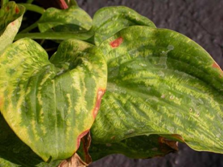
Leaf mottling, twisting and puckering
can be signs of Hosta virus x
Hosta virus x
It’s difficult to spot this relatively new disease because symptoms vary on different cultivars. Generally, look for leaf mottling, like in the photo here. Twisting, stunting or puckering of foliage and stems are also warning signs.
Once you find a hosta that has it, get the plant out of your garden. This virus spreads easily through the sap, so anytime you cut a leaf, divide a clump or remove flower stems you could be spreading the disease. Prevent this by dipping tools in a 10:1 water to bleach solution before moving onto another plant.
Slugs
If you are finding holes on your hosta leaves, slugs are probably the culprit!
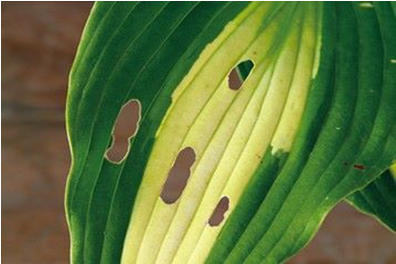
Slugs are probably the most common pest you’ll find on Hosta. If you notice irregular holes like these during the growing season, one option is to get out the Sluggo® or other iron phosphate bait.
If you prefer nonpoisonous options, here are 4 easy ways to stop these chubby munchers!
Dealing with slugs in the garden
Strolling through the garden, you find your Hosta looking like Swiss cheese. What could have committed such a crime? The likely culprit: slugs. These slimy, rasp-toothed rascals love moist, shady conditions and lush new growth. These globs of goo are hard on Hosta, but they aren’t picky — you’ll find them on other plants, too.
I’ve wrangled a lot of slugs in my garden and have a few control tips to share. Of course, you can use slug bait. Most of today’s baits aren’t as toxic as the old formulas used to be. But I’d rather stick with non-poison options when I can. These low-impact techniques do a good job of keeping slugs away from my most prized plants, and there’s nothing in these methods to harm beneficial insects, pets or people. Read on, then head on out to the garden to rid your garden of these slimy pests!
Get rid of slugs with traps
Instead of picking slugs one by one from your plants, use food or hiding places to collect them in one place, then drop them into a bucket of soapy water, feed them to your chickens or (eek!) squash them underfoot.
Placing citrus halves in the garden will attract slugs and make them easier to dispose of.
- Put out citrus to attract slugs

Slugs love citrus! Buy inexpensive oranges or grapefruit (you don’t need the nicest fruit) for slug traps, or use rinds left over after you’ve squeezed some orange juice. Leave the citrus halves near vulnerable plants — the slugs usually hop off the Hosta and hustle over to investigate this new offering. Check your citrus traps about once a day so slugs don’t have a chance to drift back onto your plants.
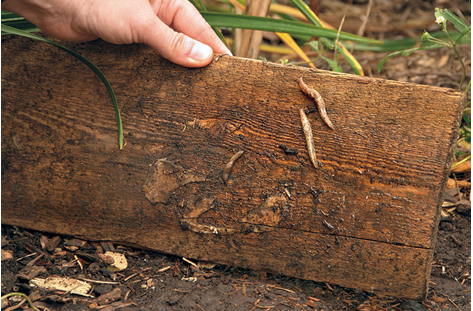
Placing a wooden board in the garden will attract slugs and can be easily removed.
- Create a simple board trap
A board on the ground in a shady spot might not look like much to you, but to slugs, it looks like a great place to spend the day. Tuck a 1- or 2-ft.-long piece of board under plants to create a moist, shady hiding place that’ll attract lots of slugs. Slugs are active at night, but during hot days, they retreat under mulch, rocks…or board traps. Check the trap in the afternoon, when slugs are enjoying their siesta under your board.
- Use copper pan scrubbers to deter slugs
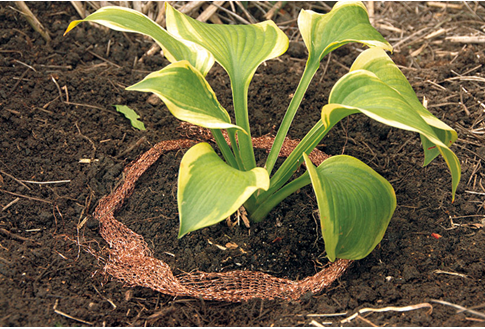
Copper pan scrubbers from the grocery store are a cheap idea for use in the garden to deter slugs.I’ve also had good luck with copper pan scrubbers from the grocery store. These copper mesh bundles can be pulled out into long, thin ribbons and pressed into the soil around the plant, as I did in the inset of the photo. (Pin them in place with landscaping pins if you’re having a hard time keeping them in contact with the soil.) When using these scrubbers, I think the sharp edges are just as unpleasant for the slugs as the copper itself. Make sure that the ends overlap so there’s no gap to let slugs in.
- Beer?
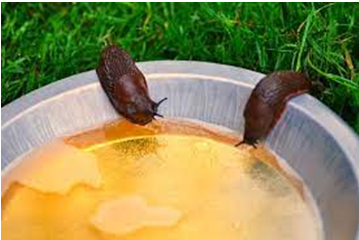
You can make a slug beer trap out of any kind of upcycled container – as long as it has a wide opening and can hold a couple inches of beer inside. Most gardeners use wide shallow containers, though I’ve seen some beer traps that are narrow and deep (like a water bottle).
Save and rinse out cat food cans, dog food cans, or tuna cans. Other ideas include plastic food storage containers, aluminum pie pans, used cottage cheese, yogurt, margarine, or sour cream tubs, cut water bottles, plastic cups, or similar. I’m sure you already have something on hand!
What’s the best beer for slug traps?
Slugs and snails are not too picky about their beer. Any beer can work in a trap, though slugs seem especially drawn to light, yeasty beers like lagers, pilsners, hefeweizen, or blonde ales. Plus, slugs are a cheap date – no need to give them your premium brews!
One note of caution when using beer…I tried this once and it did work. However – my Golden Retriever Maggie liked it more than the slugs! So, keep this in mind if you have dogs (or kids)!
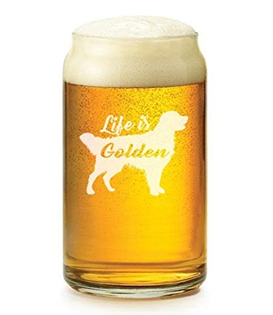
Picture from Amazon
Source: Homestead and Chill
Garden Gate






